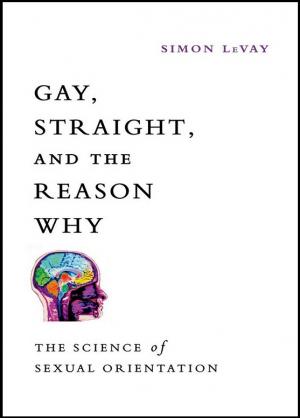Gay, Straight and the Reason Why: The Science of Sexual Orientation

I recently had the pleasure of participating, as a feminist blogger, in a survey about the Feminist Blogosphere. Name? Age? Sex (or "gender," as she put it)? These were not difficult questions (for me) to answer. But when she asked me to identify my sexual orientation, I paused... and then I stumbled. “I’m straight, right?” I asked myself. I’m a woman married to a man. If sexuality is either one of two, possibly three, things, then quite obviously I am a heterosexual. But as Gore Vidal sharply put it: “Trust a nitwit society like this one to think that there are only two categories—fag and straight.”
The fact that I lead a heteronormative life means that I am “normal,” “average,” and “healthy,” doesn’t it? And as I have been leading a universally accepted lifestyle, I am afforded the privilege of thinking of sexuality—not as something that forms the core of one’s identity—but rather as something within a spectrum, and something that enhances one’s identity. When homosexuals have demanded the right to be so-called Lesbians and Gays as part of a movement of identity distinction and defense of their acceptability, I have often thought that, in actuality, said lesbians and gays are no different from me, just people with sexualities that fall elsewhere on the spectrum. But according to the neurologist Simon LeVay, heteros and homos are different on neurological, hormonal, and genetic levels.
May Simon LeVay’s overview of the science of sexuality, which he was instrumental in founding, Gay, Straight and the Reason Why, be admitted into the pantheon of sexual discourse housing Michel Foucault, Eve Sedgwick, Judith Butler, et al.—though he is in disagreement with many queer theorists having identified, as he claims, the scientific reasons for human homosexuality. Disputing the Kinsey scale and its seven categories, for instance, LeVay points out that most “non-heterosexual men are homosexual; few say that they are roughly equally attracted to both sexes.” However, he also points out that pathology doesn’t enter into “who we love”: “There’s nothing wrong with gay people,” he writes in his introduction. “I’m gay myself, and happy to be so. There are some differences between us and the rest of humanity, certainly, as I’ll discuss in this book. Some of these differences are trivial, and some may influence people’s lives in interesting ways…”
I really enjoyed reading this book. Surprised? I was. In the first place, I struggle to understand science. But LeVay has written this text with laypeople like me in mind. Technical terms are italicized when first employed and subsequently defined in a comprehensive glossary at the back of the book. Hence, reading about neurons and genes and hormones was like reading a recipe for shortbread cookies. While my literary academic background in sexuality and queer theory came in handy and my prior interest kept me engaged, I do believe this book is appropriate for anybody with rudimentary knowledge of sexuality and a genuine interest in understanding it.
One practical dilemma arises were society to apply LeVay’s finding—that homosexuality results in part from a size discrepancy in a cluster of nerves found in the hypothalamus—to everyday life: we’d need “new rules.” If most men, for instance, are heterosexual, but those who aren’t have a smaller than normal INAH3, then could homosexuality and its physical cause be considered a disability? Are homosexuals, with their observed differences from heterosexuals, disadvantaged because of this physical abnormality/disability (not taking into account the social stigma against homosexuality, whatever its root)? And what about people with normal INAH3 who exhibit homosexual longings or tendencies? What is our science? “All mental traits, including sexual orientation, have some durable representation in the brain,” LeVay reports. I find Ashley Judd, and not Angelina Jolie, sexually attractive. Can an explanation for that be found in my brain, or is it beyond pathology and part of the aforementioned “who we love” question? Can sexuality have a spiritual component?
LeVay’s discussion of gender is problematic for queer theory enthusiasts like me. While he concludes that gender traits are a “kaleidoscopic blend” amongst homosexuals, his science contradicts often this notion. He affirms that gay men are on average more “feminine” by their own account, and lesbian women more “masculine” by their own account, than their straight counterparts. This plays into the reductive Freudian (among other) expectation that human sexual relationships must consist of symbiotic masculine and feminine parts. Furthermore, there is evidence that suggests homosexuals have different anatomical makeup than heterosexuals. LeVay does not shy away from using potentially pejorative language: “…lesbians who identify as ‘butch’ have a higher (more male-like) waist-hip ratio than do straight women, whereas lesbians who identify as ‘femme’ have the same ratio as straight women. Because the waist-hip ratio rises if people become overweight, this difference does not necessarily represent a constitutional difference between butch and femme lesbians: It could simply be that butch lesbians have less interest in dieting or maintaining a ‘feminine’ profile.”
Gay, Straight and the Reason Why is full of these types of observations, the things we’re thinking about when we ponder about our human differences, but are often afraid to say aloud; and I give LeVay a lot of credit for his candor. Ultimately, his observations and those of his colleagues detailed herein make our eliminating the language and expectation of gender seem far, far away. But I appreciate good, thorough, critical discourse such as that which can be launched with documented research of this kind. I hope this text finds its way into many graduate seminars across many areas of study: from science to literature and film, and more!